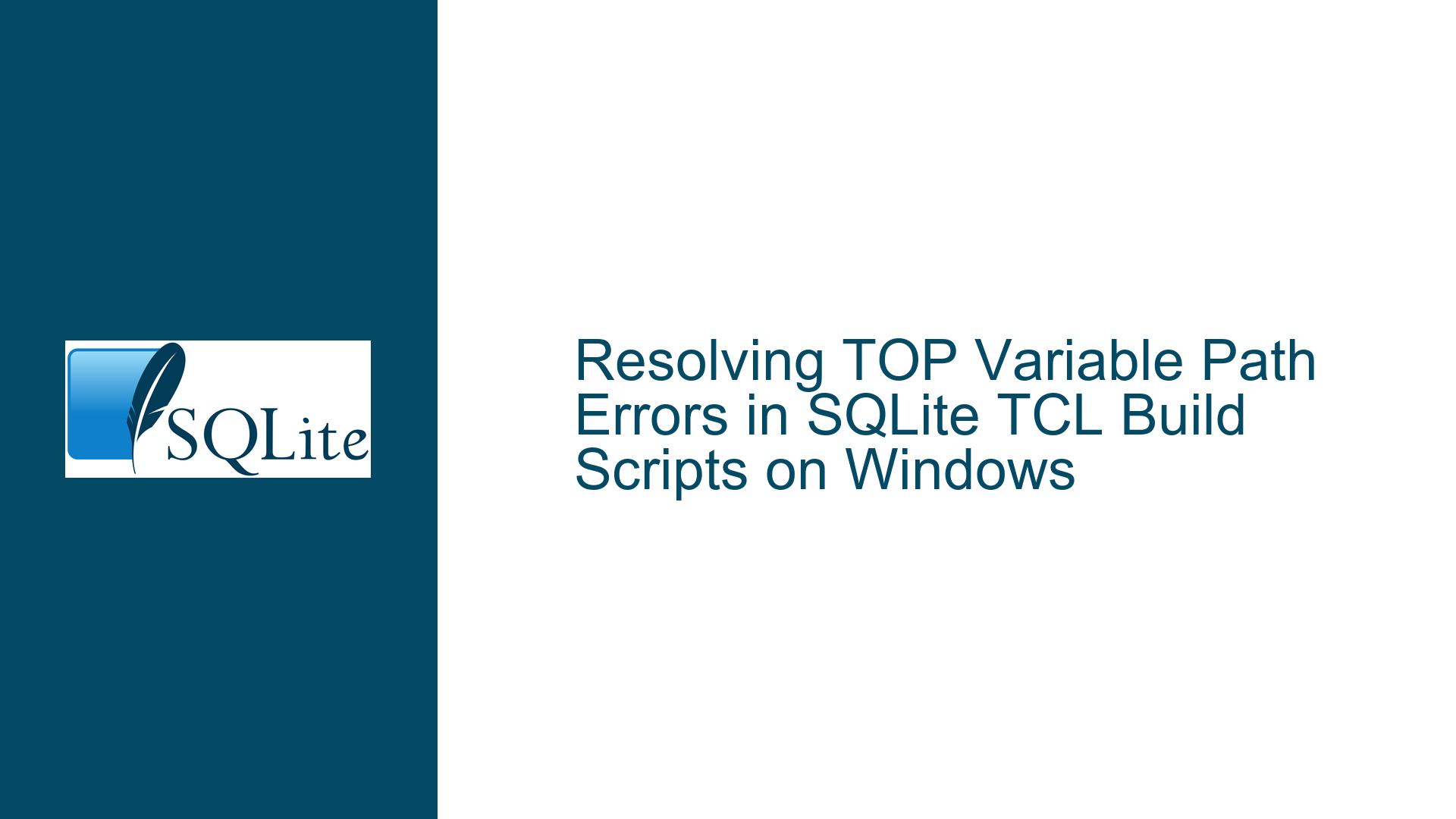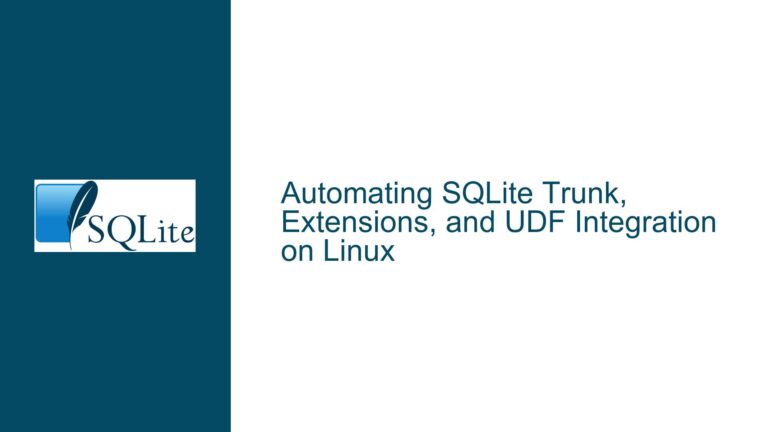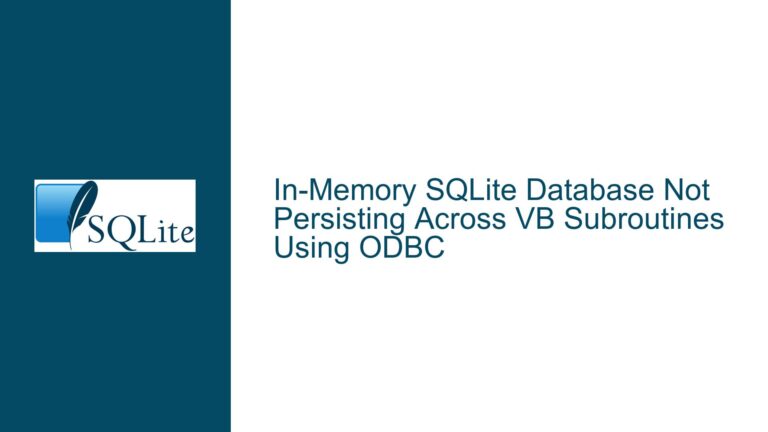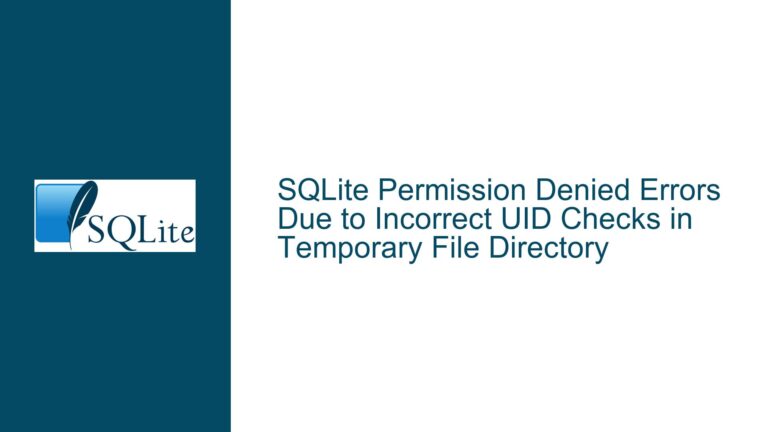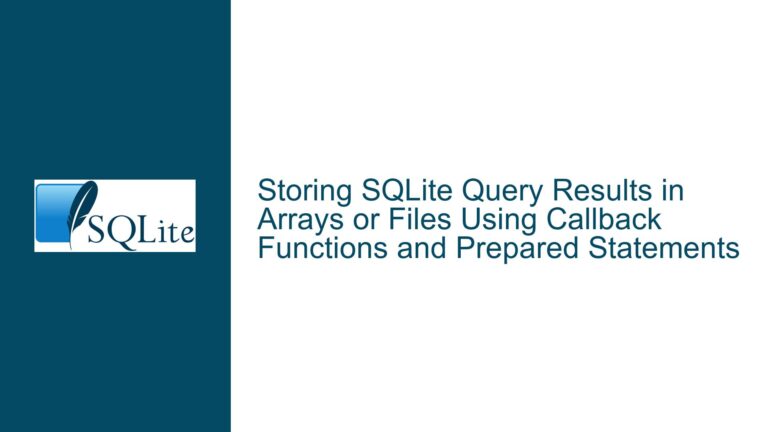Resolving TOP Variable Path Errors in SQLite TCL Build Scripts on Windows
Build Script Misconfiguration Due to Incorrect TCL Environment and TOP Variable Handling
Issue Overview: TCL Script Path Resolution Failures During SQLite Compilation
When attempting to compile SQLite from source on Windows using the provided Makefile.msc and nmake, users encounter errors indicating that critical header or source files (e.g., fts5.h, fts5.c, or shell amalgamation components) cannot be located. These errors arise during the execution of TCL scripts (mkshellc.tcl, mkfts5c.tcl) responsible for generating amalgamated source files. The root cause is improper resolution of the TOP variable—a parameter designed to specify the root directory of the SQLite source tree. When the TOP variable is not correctly propagated to these TCL scripts, they default to hardcoded or relative paths that do not align with the actual directory structure, leading to "file not found" errors.
Key Symptoms
- Missing File Errors During Build:
couldn't open "./fts5.h": no such file or directoryerror: cannot open source file "sqlite3ext.h"- Similar errors referencing components in
ext/,tool/, or other subdirectories.
- Manual Script Modification Required:
Users resort to editing TCL scripts to hardcode paths (e.g., replacing%dir%with absolute paths), which bypasses the intended build process. - Inconsistent Behavior Across Environments:
The build succeeds on some machines but fails on others, depending on the TCL interpreter version, directory structure, or environment setup.
Technical Background
The SQLite build process relies on TCL scripts to concatenate source files into amalgamated outputs (sqlite3.c, sqlite3.exe). These scripts use the TOP variable to locate the root directory of the source tree. For example, mkfts5c.tcl constructs the path to fts5.h as $topdir/ext/fts5/fts5.h. If TOP is not correctly set, the script searches for fts5.h in the current directory or an incorrect relative path, resulting in failure.
The Makefile.msc is designed for use with Microsoft Visual C++ (cl.exe, nmake) and assumes a specific environment setup, including:
- Availability of
tclsh.exe(TCL command-line interpreter) in thePATH. - Execution from a build directory separate from the source tree (to avoid pollution).
- Correct inheritance of environment variables (e.g.,
INCLUDE,LIB) for MSVC tools.
Possible Causes: TCL Environment Misconfiguration and Build Process Deviations
1. Incorrect or Incompatible TCL Interpreter
The TCL scripts (mkshellc.tcl, mkfts5c.tcl) require a compatible tclsh.exe interpreter. Common issues include:
- MSYS2/MinGW TCL Interpreter: Using
tclsh.exefrom MSYS2 (msys64\usr\bin\tclsh.exe) or MinGW installations, which may lack compatibility with Windows-native path handling or MSVC-generated binaries. - Missing TCL Installation: No
tclsh.exein thePATH, causing the build process to fail at the first TCL script invocation. - Version Mismatches: Older TCL versions with bugs in file handling or variable substitution.
2. Improper Build Directory Structure and TOP Variable Usage
The SQLite build process expects a specific directory hierarchy:
<SQLITE_SOURCE_ROOT>/
├── ext/
├── tool/
└── Makefile.msc
Users should create a separate build directory (e.g., bld/) to isolate object files and binaries. Failing to set TOP=.. when invoking nmake from this directory causes the TCL scripts to resolve paths relative to the build directory instead of the source root.
3. Environment Configuration for MSVC Tools
The Makefile.msc assumes the command prompt is configured for MSVC (e.g., via vcvarsall.bat). Symptoms of improper setup include:
nmakenot recognizing MSVC compiler/linker options.- Environment variables (
INCLUDE,LIB) not pointing to Windows SDK or MSVC libraries.
4. Case Sensitivity and Path Delimiters
TCL scripts may mishandle Windows-style backslashes (\) in paths if the interpreter expects Unix-style forward slashes (/). This is common when using MSYS2-derived TCL interpreters.
Troubleshooting Steps, Solutions & Fixes
Step 1: Validate TCL Installation and Interpreter Compatibility
Verify TCL Availability
Open a Command Prompt and execute:
where tclsh.exeThis should return the full path to
tclsh.exe(e.g.,C:\Tcl\bin\tclsh.exe). If no results appear, install ActiveState TCL from https://www.activestate.com/products/tcl/.Check TCL Version:
tclsh -c "puts [info patchlevel]"Ensure the version is 8.6 or newer.
Resolve MSYS2/MinGW TCL Conflicts
If where tclsh.exe returns a path under msys64\ or MinGW\, reorder the PATH variable to prioritize ActiveState TCL:
- Open System Properties > Environment Variables.
- Edit the
PATHvariable, movingC:\Tcl\bin(or your ActiveState install path) above MSYS2/MinGW entries.
Step 2: Establish Correct Build Directory Structure and TOP Variable
Create a Clean Build Environment
- Source Tree: Unpack the SQLite source code into a directory without spaces or special characters (e.g.,
C:\sqlite-src-3420000). - Build Directory: Create a separate directory for building:
cd C:\sqlite-src-3420000 md bld cd bld
Invoke nmake with Explicit TOP Variable
From the bld directory, run:
nmake /f ..\Makefile.msc TOP=.. sqlite3.c
nmake /f ..\Makefile.msc TOP=.. sqlite3.exe
The TOP=.. argument tells the Makefile (and subsequently, the TCL scripts) that the source root is one directory above the build directory.
Step 3: Diagnose TCL Script Path Handling
Enable Debugging in TCL Scripts
Modify tool\mkshellc.tcl and ext\fts5\tool\mkfts5c.tcl to print the resolved topdir:
- Open
tool\mkshellc.tcland add after line 12:puts "DEBUG: topdir = $topdir" - Repeat for
ext\fts5\tool\mkfts5c.tcl, adding:puts "DEBUG: topdir = $topdir" - Rerun the build. The debug output should show the correct source root (e.g.,
C:/sqlite-src-3420000).
Fix Path Delimiter Issues
If the debug output shows mixed slashes (e.g., C:\sqlite-src-3420000/ext/fts5), modify the TCL scripts to normalize paths:
set topdir [file normalize $TOP]
set topdir [regsub -all {\\} $topdir {/}]
Step 4: Configure MSVC Developer Command Prompt
Use VS Developer Command Prompt
- Launch Developer Command Prompt for VS 2022 (or your VS version).
- Navigate to the build directory (
bld). - Rerun the
nmakecommands.
Validate Environment Variables
In the command prompt, verify critical variables:
echo %INCLUDE%
echo %LIB%
where cl.exe
These should point to valid MSVC and Windows SDK directories.
Step 5: Rebuild with Clean Slate
Remove Previous Build Artifacts
From the bld directory, delete all files except those created by you (e.g., del * /Q).
Execute Full Build Sequence
nmake /f ..\Makefile.msc TOP=.. clean
nmake /f ..\Makefile.msc TOP=.. sqlite3.c
nmake /f ..\Makefile.msc TOP=.. sqlite3.exe
Final Validation
Successful builds will generate sqlite3.c, sqlite3.h, and sqlite3.exe in the bld directory. If errors persist, re-examine the TCL debug output and environment variables. Persistent issues may require reinstalling ActiveState TCL or repairing the MSVC toolchain.
By methodically validating each component of the build environment—TCL interpreter, directory structure, TOP variable usage, and MSVC configuration—users can resolve path resolution errors without resorting to manual script modifications.
